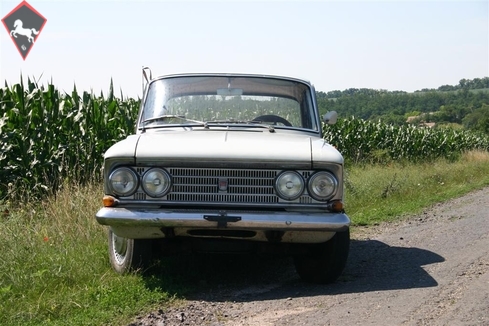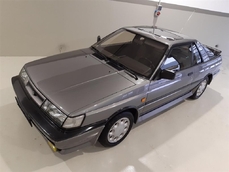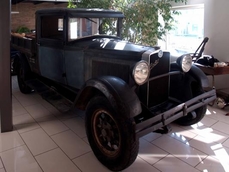Moskvitsh 408 1968
General description :
1968 Moskvitsh 408 is listed for sale on ClassicDigest in Budaörs by Victory Budaörs Autó Kft for €4500.
Car Facts
Car type : Car Make : Moskvitsh Model : 408 Engine size : 0.0 Model Year : 1968 Location : Gyár u. 2 2040 Budaörs, Hungary Vehicle Registration : Undefined
4500 €
People who viewed this Moskvitsh 408 also viewed similar Moskvitsh listed at ClassicDigest
Other cars listed for sale by this dealer
About Moskvitsh
In the wake of August 1945, a certain manufacturing facility received a makeover, transforming into the Moscow Plant of Small Cars (MZMA). This pivotal moment marked the inception of a new chapter for motoring in the Soviet Union.Enter the Moskvitch 401, an emblem of post-war ingenuity. Following the upheaval of World War II, the Soviet Union sought recompense for its industrial losses, acquiring German vehicle technology as part of war reparations. Amidst this quest, the Opel Kadett K38 emerged as a suitable match, embodying the desired specifications akin to the KIM 10.
By August 1945, the State Defense Committee issued Order No. 9905, mandating the commencement of Kadett production under the Moskvitch-400 moniker. Yet, the implementation was no mean feat. The Opelwerk Brandenburg, deeply entrenched in Nazi Germany's war machinery, lay in ruins post-allied bombardment. Nevertheless, the Soviet-German collaboration, aided by captured Kadetts and oversight by the Soviet Military Administration in Germany, facilitated this endeavor.
The tumultuous aftermath of the war didn't deter progress; production of the Moskvitch 400-420 commenced in December 1946. This series persisted for a decade, evolving into the refined Moskvitch 401. An impressive tally of 247,439 units, including exports to Belgium, East Germany, and Norway, marked this historical phase.
Enter the second generation of motoring marvels, as MZMA ushered in fresh designs from 1956, bringing forth the Moskvitch 402 and its subsequent variants. This wave of innovation witnessed the introduction of models such as the Moskvitch 403 and the acclaimed Moskvitch 407. These models boasted enhancements in the form of independent suspension, upgraded interiors, and even included radios, mirroring the allure of counterparts like the Hillman Minx, Fiat 1100, and Ford Consul.
The Moskvitch 402 series served as a pioneering step in Soviet automotive history, adapting models for diverse utility cases. The Moskvitch 407, while enhancing driving comfort, diversified into multiple trim levels, including station wagons, vans like the Moskvitch 431, and even the ambitious off-road sedan/station wagon, the Moskvitch 410/411. Astonishingly, the M-407 achieved unprecedented success in the Western market, with up to half of its production reserved for export, notably to Eastern Bloc nations, Norway, Finland, and France.
Venturing into the 1960s birthed the third generation of automobiles, introducing the Moskvitch 408, Moskvitch 412, and the notable Moskvitch 2140. A hallmark moment came on May 18, 1967, when the one millionth car rolled off the assembly line. The Moskvitch 408 blazed trails as the first Soviet-built car consciously designed with enhanced safety features, including crumple zones, a safer steering column, seat belts, and a split circuit braking system.
Evolution didn't halt; the refined Moskvitch 408 of the second series, spanning 1969 to 1976, embraced updated aesthetics featuring rectangular headlights, horizontal rear lights, and a shift towards separated bucket seats. Embraced for its value, the Moskvitch 408 gained popularity in nations like the United Kingdom, Finland, and Norway. Its successor, the Moskvitch 412, further elevated the design through various engine and style enhancements.
This epoch witnessed an alliance between MZMA and Renault, forged during French President Charles de Gaulle's visit to the Soviet Union in 1966. This partnership aimed to revitalize the Moscow plant and establish a new facility in Izhevsk.
The journey continued in 1969 with an overhauled design for both the 412 and the related 408, boasting rectangular headlights and horizontal rear lights. Notably, safety standards soared, leading the Moskvitch 412 to secure international safety certificates following rigorous testing across Europe. Amidst these advancements, the factory underwent a renaming ceremony in October 1968, christening itself as the Automobile Factory in Honour of the Leninist Communist Youth Union (AZLK) to commemorate the Komsomol's 50th anniversary.
The Moskvitch legacy extended into motorsport as SATRA Motors thrust M-412s into the Group One Production Saloon Car Championship in 1972 and 1973, outperforming renowned British competitors. Further improvements ensued with the advent of the Moskvitch 2138 and Moskvitch 2140, leveraging a modified Moskvitch 412 platform.













